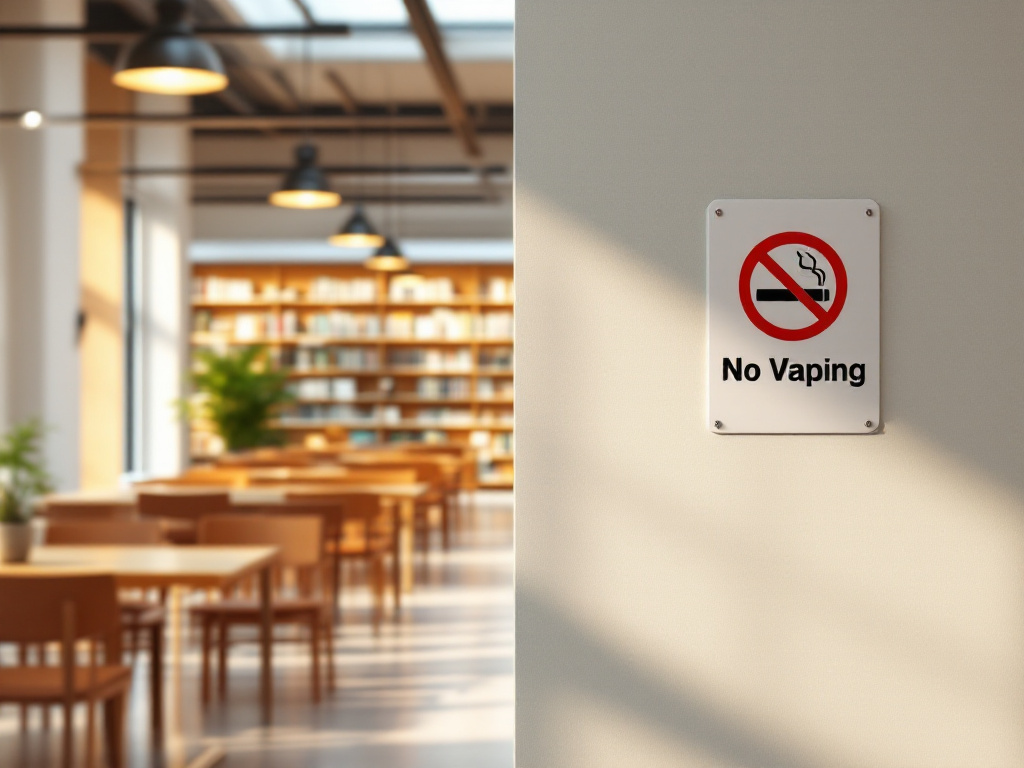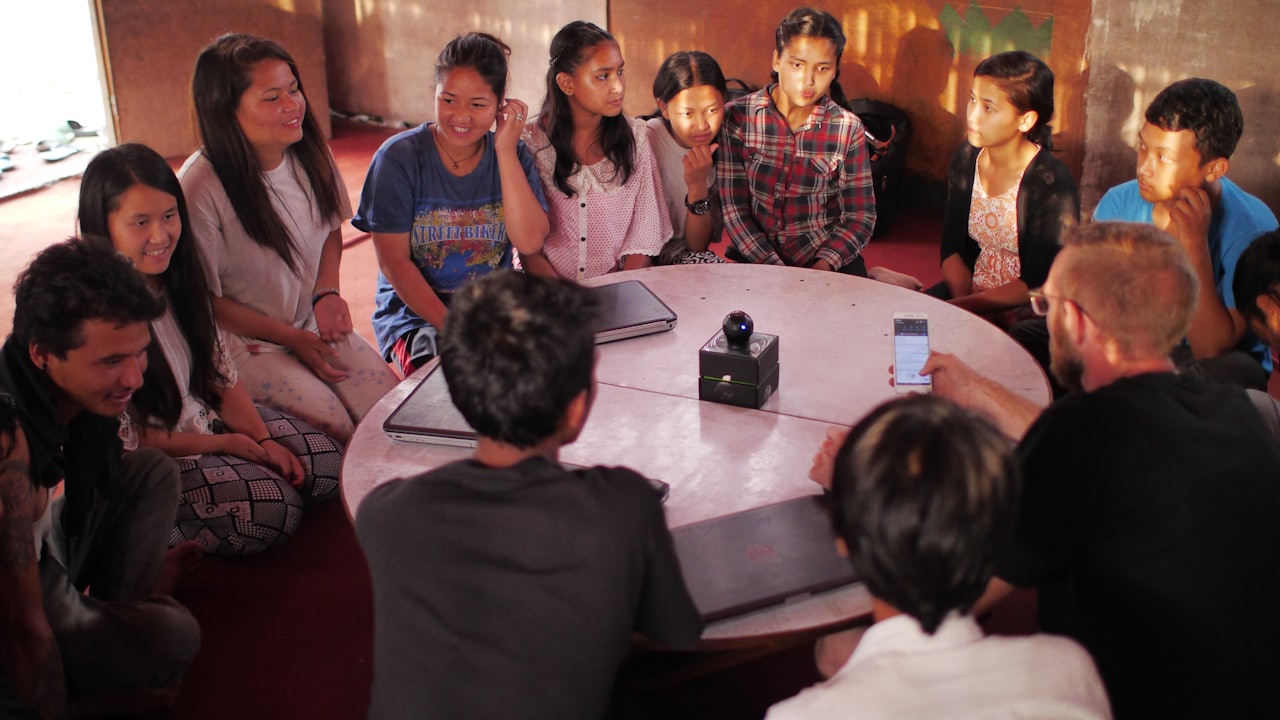Vape Prevention for Libraries
As libraries nationwide grapple with the rising challenge of e-cigarette use in their spaces, this guide offers practical strategies and evidence-based approaches to help library staff create and maintain vape-free environments while preserving their role as welcoming community spaces.

Discover Your Library
Welcome to Rosswell Public Library, where youth education and reading thrive.


-
The Growing Challenge of Vaping in Libraries: A Prevention Guide

Libraries have long served as sanctuaries for learning, research, and community gathering. However, in recent years, library staff across the country have found themselves facing an unexpected challenge: the rise of vaping within library spaces. This concern is particularly pressing given recent statistics showing that 27.5% of high school students report e-cigarette use in the past 30 days, and among young adults aged 18-24, 18% report current use of vaping products.
The challenge libraries face reflects a broader societal trend. While overall adult vaping rates in the U.S. hover around 4.5%, the significantly higher rates among young people – nearly one-third of high school-aged students – create unique challenges for public spaces like libraries that serve diverse age groups[3,4]. As centers of youth and community activity, libraries find themselves at the intersection of public health policy and community service.
The impact extends beyond mere policy enforcement:
- Air Quality: Unlike traditional cigarettes, vapor can be less detectable but still affects indoor air quality and patron comfort
- Health Considerations: Second-hand vapor exposure raises health concerns for both staff and patrons, particularly in enclosed spaces
- Enforcement Difficulties: The discrete nature of modern vaping devices makes detection and policy enforcement increasingly complex
- Resource Allocation: Staff time and energy spent monitoring and addressing vaping incidents takes away from core library services
Research has shown that Indoor Vaping Restrictions (IVR) in public places can effectively influence vaping behavior. Currently, IVR coverage averages 24.6% for workplaces and 26.6% for both restaurants and bars, suggesting room for more comprehensive policies in public spaces like libraries[5]. As community institutions, libraries have an opportunity to lead in establishing clear policies and prevention strategies.

Signs and Detection: Recognizing Vaping Activity in Your Library
Library staff’s ability to identify vaping activity is crucial for maintaining a safe and healthy environment. While modern vaping devices are designed to be discrete, there are several tell-tale signs that can alert attentive staff members to potential vaping situations. The most immediate visual indicators often appear as unusual clouds or mist that dissipate quickly, accompanied by unexplained sweet or fruity odors wafting through the air.
The challenge of identifying vaping activity has grown more complex as devices become increasingly sophisticated. Staff need to be aware of both obvious and subtle signs, particularly in areas that offer more privacy or have limited oversight. Understanding these patterns and knowing where to look can make the difference between effective prevention and missed opportunities for intervention.
Key Visual and Behavioral Indicators
- Unusual clouds or mist that dissipate quickly
- Sweet or fruity odors that seem out of place
- Patrons frequently covering their mouth or nose with clothing
- Groups huddling in corners or between shelves
- Frequent, short trips to specific areas
- Unusually high traffic in typically quiet areas
Modern vaping devices present a particular challenge as they’re increasingly designed to resemble everyday items. What appears to be a simple USB drive or pen might actually be a vaping device. This disguise makes detection more challenging for library staff and requires increased vigilance and awareness of current trends in vaping technology.
Common Hiding Spots to Monitor
- Study carrels, especially those in remote locations
- Between book stacks, particularly in less-trafficked sections
- Private study rooms and restrooms
- Stairwells and areas near emergency exits
- Areas with limited security camera coverage
Staff should pay particular attention to behavioral patterns, which can often be the most reliable indicator of vaping activity. Regular observation may reveal patrons demonstrating unusual behaviors such as cupping their hands near their face while constantly checking their surroundings. Some individuals might turn away from others while bringing something to their mouth or gather in the same spots at regular intervals.

Prevention Strategies: Creating a Vape-Free Library Environment
The most effective approach to preventing vaping in libraries combines physical space management, clear policies, and proactive staff engagement. While complete prevention may be challenging, implementing a comprehensive strategy can significantly reduce vaping incidents and create a healthier environment for all patrons.
Physical modifications to your library space can serve as powerful deterrents without compromising the welcoming atmosphere that libraries strive to maintain. Improved lighting in traditionally dim areas, such as between tall stacks or in quiet study corners, can discourage unwanted behavior while enhancing the overall user experience. Strategic placement of security cameras – with appropriate signage indicating their presence – can also serve as an effective deterrent while respecting privacy concerns.
Essential Policy Elements
- Clear signage prohibiting vaping in all library spaces
- Specific consequences for policy violations
- Guidelines for staff intervention
- Documentation procedures for incidents
- Appeals process for disputed violations
Staff training forms the backbone of any successful prevention program. Library personnel need to feel confident in their ability to recognize, respond to, and document vaping incidents. This includes understanding both the technical aspects of detection and the interpersonal skills required for addressing violations professionally and safely.
Technology Solutions
- Detectors in high-risk areas
- Modern security cameras with improved low-light capability
- Environmental monitoring systems
- Digital reporting tools for incident tracking
- Anonymous tip submission systems
Creating an action protocol helps ensure consistent responses across all staff members and shifts. When a vaping incident occurs, staff should know exactly what steps to take, from initial observation to final documentation. This systematic approach not only improves effectiveness but also provides legal protection for the library and its staff.
The most successful prevention strategies often incorporate regular evaluation and adjustment. What works in one library may need modification in another, and what works today may need updating as vaping technology evolves. Maintaining open communication channels with other libraries and staying informed about emerging trends helps ensure your prevention strategy remains effective.

Community Engagement: Building Partnerships for Prevention
Creating an effective vape-free environment extends beyond the library’s walls and requires meaningful collaboration with the broader community. By engaging various stakeholders and fostering partnerships, libraries can develop more comprehensive and sustainable solutions to the vaping challenge.
Educational initiatives serve as the cornerstone of community engagement. Rather than focusing solely on prohibition, libraries can position themselves as information hubs where young people and adults alike can access accurate, science-based information about vaping. This might include hosting health experts for informational sessions, creating resource displays, or developing teen-focused educational programs that address vaping without judgment or criticism.
Effective Partnership Opportunities
- Local schools and school librarians
- Public health departments
- Youth organizations and teen advisory boards
- Parent groups and community organizations
- Mental health professionals
- Local law enforcement’s community outreach division
The key to successful programming lies in making it relevant and engaging rather than preachy or dismissive. Consider hosting events that focus on positive alternatives to vaping. This might include stress-management workshops, art programs, gaming tournaments, or other activities that provide healthy social outlets for young people who might otherwise be drawn to vaping as a social activity.
Youth-Led Initiatives
- Teen advisory board participation in policy development
- Peer-to-peer education programs
- Student-created anti-vaping campaigns
- Youth-led library programs and events
- Social media awareness campaigns
Building trust with young patrons is particularly crucial. When teens feel respected and included in the conversation, they’re more likely to comply with policies and may even become advocates for maintaining a vape-free environment. This might mean creating a teen advisory board specifically focused on this issue or including young people in discussions about policy development and enforcement.
Remember that community engagement is an ongoing process, not a one-time effort. Regular communication with community partners, consistent programming, and openness to feedback and new ideas help ensure that prevention efforts remain relevant and effective over time.

Implementation Tips: Putting Prevention into Practice
Moving from policy to practice requires careful planning and clear communication. Success lies not just in creating rules, but in implementing them in a way that maintains the library’s welcoming atmosphere while effectively addressing the vaping challenge.
Clear communication forms the foundation of successful implementation. Post signage that is both visible and professional, avoiding overly aggressive or negative messaging. Consider using positive language that emphasizes respect for shared spaces rather than focusing solely on prohibition. For example, “Help us maintain clean air for all” resonates better than “No vaping allowed.”
Staff Response Guidelines
- Approach situations calmly and professionally
- Use non-confrontational language
- Focus on library policies rather than personal judgment
- Document all incidents consistently
- Know when to involve supervisors or security
- Prioritize staff and patron safety
Documentation plays a crucial role in effective policy enforcement. Maintaining detailed records of incidents helps identify patterns, evaluate the effectiveness of prevention strategies, and provide support for policy decisions. However, this needs to be balanced with patron privacy concerns and library values.
When addressing violations, de-escalation techniques become essential tools for staff. The goal is to maintain a safe and respectful environment while enforcing policies. This means staying calm, using a neutral tone, and focusing on behaviors rather than making assumptions about individuals. Consider this example approach:
“I notice there’s a sweet smell in this area, and I want to remind you that our library is a vape-free space. Can I help you find a more comfortable place to study?”
Implementation Checklist
- Ensure all staff members understand policies and procedures
- Create clear reporting chains for different situations
- Establish consistent consequences for policy violations
- Develop templates for incident documentation
- Schedule regular staff training updates
- Plan regular policy review and updates
Remember that consistency is key – all staff members should respond to violations in similar ways, regardless of their personal views on vaping. This unified approach helps prevent confusion and maintains the policy’s credibility with patrons.
Events and Workshops
Explore the joy of learning and reading at Rosswell Public Library. Join us for enriching events.

Book Club Meetup
Sep 15, 2026

Storytelling Hour for Kids
Nov 10, 2026

Creative Writing Workshop
Dec 02, 2026
